Astro-Physics Traveler vs. Takahashi FS102
In Search Of Excellence
by Ed Ting
Updated 11/15/98
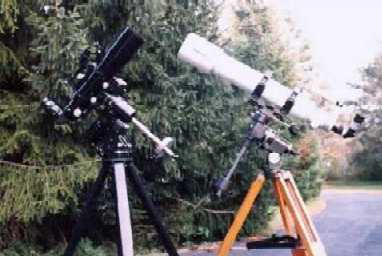 The AP Traveler and the Takahashi FS102
The AP Traveler and the Takahashi FS102Contents:
Introduction Excellence is a concept that means many things to many different people. For some, it's the mellifluous roar of a German engine as it speeds its occupants down the autobahn. For others, it's the taste of freshly- steamed Maine lobster, dipped in just-churned and melted butter. And for still others, it's the sound of a plucked or bowed Stradivarius, or the warm harmonic overtones of a Steinway. In the astronomical world these days, excellence is defined increasingly by the apochromatic refractor. These telescopes are often sought after by astronomers who have paid their dues: they've outgrown smaller achro- mats, and perhaps have done a Herschel tour or two with a large reflector. The 4"-class apochromats have flourished in recent years, and it's not hard to see why. With 4" of aperture, some of the fainter deep-sky objects are just coming into view. Planetary performance can be superb, especially with the right conditions and a good set of eyepieces. The aperture isn't quite large enough to be bothered by less-than-perfect seeing, and urban dwellers won't get an eyepiece full of skyglow from their backyards. If you need to travel, the scope is still portable. Finally, the price, while high, is still within reach of most incomes, and the flattening curve of diminishing returns and sky-high prices for the larger lenses hasn't taken over yet. Two of the most popular and sought after apochromatic refractors on the market today come from Astro-Physics and Takahashi. While there are similarly excellent scopes from other manufacturers, it's these units that are most commonly mentioned as attainable objects of desire. You expect a lot at this level. You expect optical excellence. You also expect nice fit and finish, attention to detail, a dose of personality, and a sense of permanence, for these are not disposable telescopes. These things you get, and more, from Astro-Physics and Takahashi. I'd spent time with Travelers before, and I've owned an FS102 for about a year now, so it was high time to put these natural competitors head-to-head, to see if any consensus occurred. Here are the results.
Japanese Excellence: The Takahashi FS102 Takahashi's new "FS" generation of fluorite apochromats replace the older "FC" models. The difference, other than adding 2 mm to most aperture ranges, was that the fluorite element got moved to the front (every other similar design puts the fluorite element in the rear.) According to Takahashi, the advent of new hard multi-coatings (said to be even harder than the glass itself) allowed this change. Some feel it's just a marketing move, but no one can deny the excellent performance of these units. The scope is incredibly well-finished. There are 8 knife-edge baffles inside, and the focuser is so buttery-smooth it's a pleasure to use (when I first got the scope, every time I changed eyepieces I would root for the focus position to change just so I could use the focuser. I am a geek, I am a geek, I am a geek.)
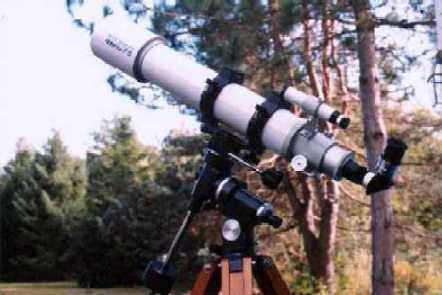 Handsome and serene, the FS102 typifies modern Japanese
excellence
Handsome and serene, the FS102 typifies modern Japanese
excellence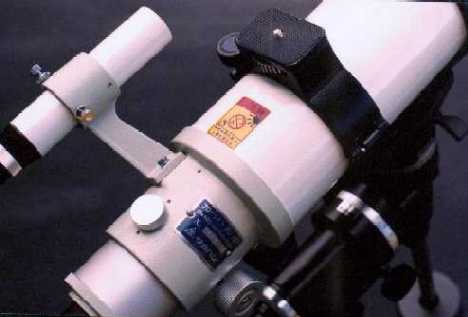 The quality is apparent even in this photo.
Remember, don't look at the sun!
The quality is apparent even in this photo.
Remember, don't look at the sun!Yankee Ingenuity and Excellence: The Astro-Physics Traveler This is perhaps the hottest scope on the market right now. With a one year (or longer) waiting list, a kind of black market has emerged, with used units selling at or above list price.
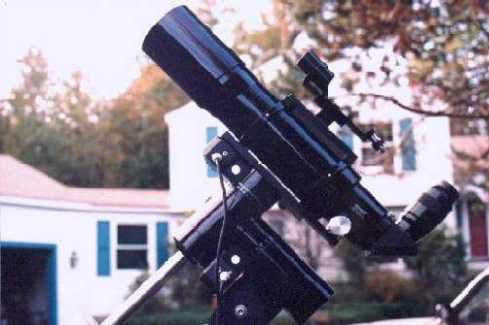 Good Guys Wear Black? The AP 105 EDFS
Good Guys Wear Black? The AP 105 EDFS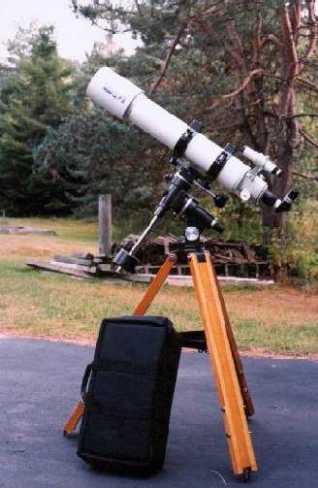
Let's go observing! For comparisons, I used the FS102 on the Super Polaris, while the Traveler spent time aboard its matching AP400 mount and the D & S tripod. The Tak rig takes only about 5 minutes to set up, but the Traveler's setup is more involved. Assem- bling the equatorial head and putting the parts of the scope together took nearly twenty minutes. I joked briefly to the Traveler's owner that the Tak rig must be better, since you spend more time looking through the scope instead of setting it up. As it turned out, the joke was to be on me later on. But first things first... Once set up, the Traveler grows quite substantially in size. A dew shield extends out from the objective, and the diagonal adds bulk to the rear end. A serious- looking dovetail assembly on top of the OTA holds the Starbeam, or other finder. The entire assemblage equals the FS102/Super Polaris rig in terms of bulk, and outweighs it by a good margin. I felt as if I had just watched a magician pull a rabbit out of a hat. This Traveler has virtually perfect optics. No false color, no spherical aberration. At high power, I thought I detected a trace of overcorrection, but it was slight at most. In contrast, the FS102, while nearly perfect, had a trace of under- correction. Also, on the limb of Jupiter, I noticed a tiny touch of false color in the FS102, which seemed independent of the eyepiece used. This wasn't entirely notice- able until I looked at the Traveler at the same object and at the same magnifi- cation. I had noticed the trace of color on my FS102 in the past, but had chalked it up to the "complicated" eyepieces I tend to use. Seeing these same eyepieces in the Traveler revealed no false color whatsoever. Both scopes showed an impressive amount of detail on Jupiter and Saturn. The lenses seemed to be "bottomless pits" for magnification - every time we thought we had maxed out on power, the scopes seemed to ask for more. Unfortunately for me, the wind was particularly strong early that night. At powers above 117X, the image would waver unacceptably. In fact, the gusts were so strong that a nearby 10" f/6 equatorially-mounted Newtonian nearby broke loose from its declination lock and came swinging down head-first into the ground. I had to hold on to my scope to keep it from toppling over. During all this, the Traveler barely budged. The image would shake a bit during gusts, but most of the time the views were rock-steady. The AP400 mount is roughly the same size as the Super Polaris, but it is far more substantial in build, and operates with a silky-smoothness that has to be seen to be believed. In fact, I came away from the evening just as impressed with the mount as with the scope itself. Fortunately, the wind died down in a half hour or so, leaving clear, calm skies, and the Takahashi was back in the game. On Saturn, the scopes were nearly identical. Saturn is half the apparent size of Jupiter, so a good barlow lens is essential when looking at it through the Traveler. The FS102 doesn't need a barlow until you get above 170X, the mag- nification when using a 4.8 mm Nagler. Despite all the extra glass in the way, the Traveler's images competed well with the Takahashi's. Call it a draw. On deep sky, the Traveler is a fun scope. Put in a 35 mm Panoptic, and you can sweep the sky at only 17X. With a 2" OIII filter, all sections of the Veil are possible. Getting the whole Veil is a stunt you can pull with a Ranger/Pronto or an Orion Short Tube, but the Traveler is sharper, gathers more light, and is simply a more substantial telescope all around. The Takahashi also excels on deep-sky. With its inherently larger image scale and higher magnification per given eyepiece, it's a bit easier to knock back the sky glow and pick out those elusive dim objects. Of course, since the Traveler takes magnification so well, it's easy to reproduce this result by simply raising the power on it. You just have to use smaller eyepieces. As a result of all this, both scopes performed well in unexpected areas. You would expect the Takahashi to excel on planets, but because the Traveler takes high magnification so well, it performs equally well (perhaps even more so, due to its superior color correction.) You expect the Traveler to excel on deep sky, but the FS102 makes up for its narrower FOV by providing a darker sky back- ground per given eyepiece. Both scopes are testaments to superb engineering. To put all of this in perspective, we briefly compared the scopes to two other fine 4" refractors present, a Vixen-based C102, and my new-found non-sdf Renaissance. Both of the achromats showed some purple fringing on Jupiter. Neither is particularly objectionable (at least to me) but compared to the Traveler or the FS102, the false color was immediately noticeable. Also, when doing low power sweeps, the apochromats remained both sharp and dark out to the edges of the field of view, while both achromats showed some elongation and some brownish brightening as you approached the field stop. I also found that the focal planes of the more expensive scopes were easier to find; that is, objects snapped tightly into focus at a certain position on the focuser, that was it, no doubt about it. The achromats, on the other hand, while both very good in this regard, took a bit longer to find focus. Finally, the AP and Takahashi scopes were impressively contrasty - stars were pure white against a pitch black background. Want an example? NGC404, the little galaxy next to Beta Andromedae, stood out quite prominently in the Traveler and the FS102 (don't ask me to pick between them, I can't.) In the Renaissance, I could still see the galaxy, but I had to hunt for it. The same results were repeated with NGC6207 next to M13 in Hercules. Des- pite being low on the horizon, the apos picked it out cleanly from the skyglow; it was questionable in the Renaissance. And before Al Nagler jumps all over me, I should point out that the newer sdf Genesis and Renaissance models will be a lot closer in performance to the AP and Tak scopes. I just didn't have one handy. I post these comparisons because I get a lot of questions from achromat owners wondering if these apochromats are worth the high asking prices. Yes, there is an improvement, yes there is a difference, and no, I don't know if it's worth it to you. You have to decide that for yourself. If you're in the market for a modern apo, look through one before buying. At the end of the evening, we broke down the scopes. Again, I noticed a rather significant difference in break down times. By the time I had both the Takahashi and the Renaissance packed away, the Traveler and its mount were still only partially disassembled. I should point out, this situation had not eluded the Traveler's owner, who does keep a TeleVue Gibraltar mount handy for quick viewing. In any event, it was fun to watch the Traveler do its disappearing act into its little black bag.
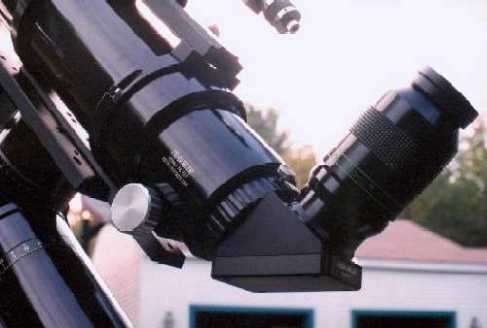 The AP Traveler eagerly awaits sunset
The AP Traveler eagerly awaits sunsetConclusions So, call it a close draw. Both the FS102 and the Traveler are superb telescopes. The Traveler has a slight edge in color correction, although some may prefer the larger image scale of the Takahashi. As I went back and forth between them, I found that my favorite was the one I had just looked through. Of the four ob- servers present, two preferred the Traveler, and two favored the FS102. I think I'll stick with my Takahashi, but I admit, there were times during the night when I was tempted to order a Traveler for myself. Both scopes are enthusiastically recommended. Looking for excellence? You've found it. End Traveler/FS102 Face Off